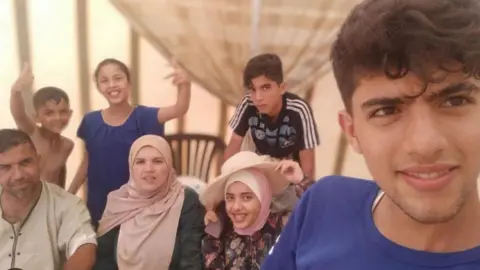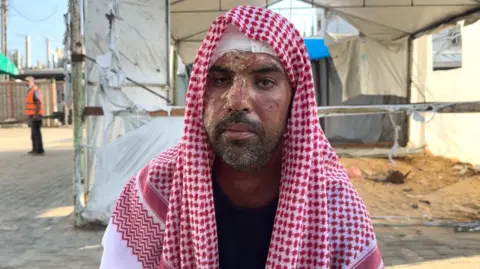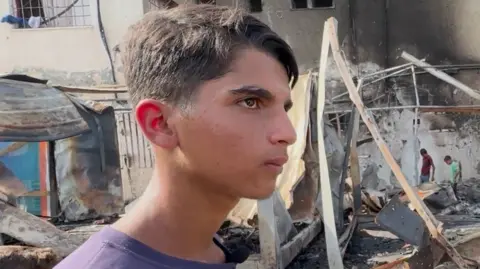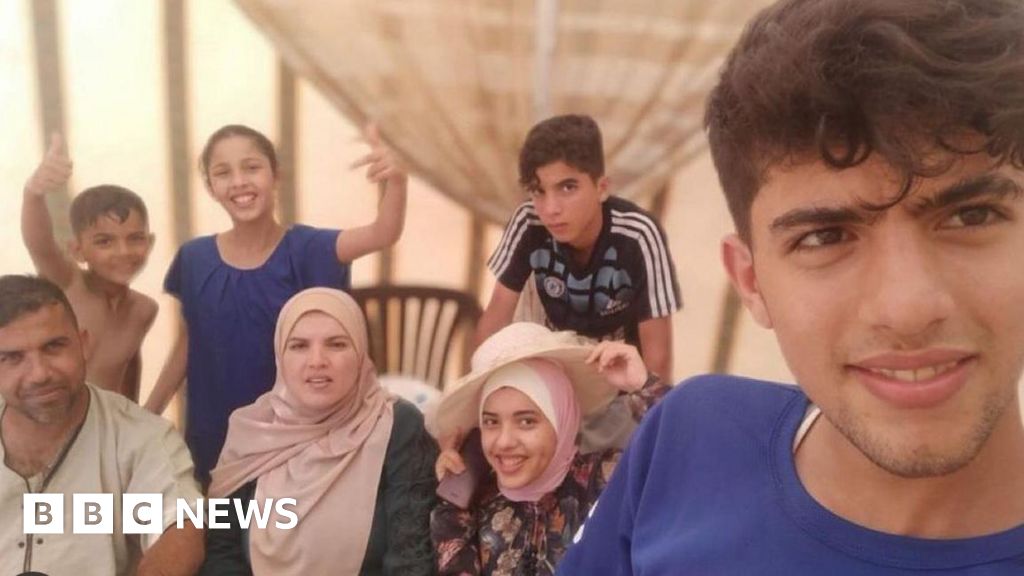 Al Darrow family photo
Al Darrow family photoWarning: This work contains graphic depictions of death and injury
I have no conscience. There is no humanity. There are only leaders who watch and do not act.
That’s what Ahmed Aldarou believes as his family’s memories come back to life in his head. He said his life was gone. He died in the inferno of the al-Aqsa compound along with his sons and wife in the early hours of Monday, October 14, after an Israeli attack.
On the ground in front of him was a cloth wrapped around the body of his youngest son, Abdulrahman, 12.
The child continued to suffer for four days after the fire caused by the Israeli military attack. The day before he died, Ahmed saw him in the hospital and was able to say to his father: “Don’t worry, I’m fine, Dad…I’m fine.” Don’t be afraid. ”
Ahmed half speaks, half cries as he talks about what was taken from him.
“I tried to pull him (Abdurrahman) out of the fire three times, but his body fell into the fire again.”
Her brother Shaaban, 19, and mother Alaa, 37, died on the night of the fire.
Sha’aban has become a new symbol of Gaza’s terrible suffering. Images of him writhing in agony as he burned in his family’s tent were shared around the world on social media.
Ahmed had burns all over his face and hands. The tone of his voice is high and sharp. Ahmed said of the anonymous pilot who sent the missile and the leaders who gave him orders. “They broke my heart, they crushed my spirit…I wish they had burned me in a fire.”
The strike occurred at around 1:15am local time last Monday (23:15pm BST on Sunday).
The Israeli military said it was targeting a Hamas “command and control” center on the grounds of al-Aqsa hospital in Deir al-Balah in the central Gaza Strip.
Hamas denies any activity inside the hospital.

Four people were killed instantly and dozens more were injured, including one who suffered severe burns. The Israel Defense Forces said it was “looking into the incident”.
A White House spokesperson told the BBC’s US partner CBS News that footage of the fire was “very disturbing” and called on Israel to take further steps to protect civilians. .
“Israel has a responsibility to do more to avoid civilian casualties. Even though Hamas was operating near the hospital in an attempt to use civilians as human shields, what happened here is That’s terrifying.”
Other powers, including the United States and Britain, have expressed concern about civilian casualties from the early stages of the war.
 Reuters
ReutersPeople are being burned, blown to death, and shot to death every day in this war.
Most of the time, the death throes occur away from the camera. A frantic search for survivors amidst the rubble, dramatic hospital scenes and interminable funerals captured on camera.
But Shaaban Aldarou’s death was different. His hand is seen reaching out from hell, his figure writhing in flames, beyond the reach of anyone’s help.
In the days following his death, videos and photos of Shaaban himself emerged. He was a typical teenager of his generation, aware of the power of social media and adept at documenting his daily life.
The image that emerged from the night of the fire emerged into the world as an outspoken, intelligent teenager, a software engineering student, a young man caring for a family planning a new life outside of Gaza. He filmed himself donating blood and encouraged others to do the same.
“We see so many injured, so many children in need of blood… All we ask is a ceasefire and an end to this tragedy.”
We are able to tell the story of the Al Darrow family thanks to local journalists who traveled to meet the survivors. International journalists from media outlets, including the BBC, are not allowed independent access to Gaza from Israel.
In a video recorded in the tent where he died, Shaaban described how his family had been evacuated five times since the war began a year ago. He had two younger sisters and two younger brothers.
“We are living in very difficult conditions,” he said. “We are suffering from a variety of situations including homelessness, limited food and very limited medicine.”
As he speaks, the loud mechanical sounds of Israeli observation drones can be heard in the background, a constant soundtrack in Gaza day and night.
Shaaban and Abdulrahman’s surviving brother, Mohamed Al-Darou, told the BBC that he had tried to jump into the flames to save his brother.
However, the other wounded men held him back, fearing that he too would be killed. Mohammed did not sleep in his family’s tent, instead keeping an eye on his family’s belongings piled up on the street outside.
“I was shouting for someone to let me go, but it was no use… My brother had his leg trapped and couldn’t get free. I think you saw it on the video. He had his hands up.
“That was my brother. He was my support in this life.”
Shaaban came in the morning with a bottle of water to wake him up for prayer and said: “I’ll work for you.”

Mohammed recalled how his brothers set up a stall at the hospital gate, selling food their family had prepared.
“We worked hard to get everything done. Everything we got came from our efforts. We were able to get food and drinks, but then… Everything is lost.”
He saw the burnt body, but could only identify the mother. Her body had been mutilated in the fire, but he recognized a distinctive bracelet.
“If it wasn’t for that, I wouldn’t have known she was my mother. Her hand was away from her body, but the bracelet was still on her hand. I took it from her hand. I took it up.”
This is my only memento of the woman who was the “kindness of our family.”
The Al Darrow family is in shock. The survivors mourn the dead. A BBC colleague asked Mohammed about the psychological cost of watching a loved one die.
“I can’t explain it. I can’t explain how it felt. I want to explain it to people, but I can’t. I can’t explain it. I saw my brother burn in front of my eyes, and so did my mother. .”
Then, as if asking the question on behalf of the dead, he asks: You see us burning and you remain silent. ”
Additional reporting by Haneen Abdeen and Alice Doyard




